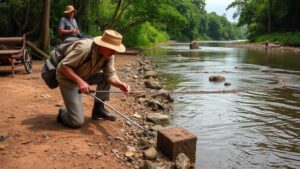Unearthing Hidden Gold Coins Buried in Overlooked Orchard Rows
Unearthing Hidden Gold Coins Buried in Overlooked Orchard Rows
The discovery of hidden treasures, particularly gold coins buried in orchards, fascinates both amateur treasure hunters and professional archaeologists alike. Overlooked orchard rows, which may appear mundane at first glance, can hold secrets from the past: historical artifacts that shed light on previous inhabitants, lost economies, and even stories of survival. This article explores the reasons coins might be buried in such locations, methods for locating them, and the archaeological and historical significance of these findings.
Understanding the Context of Buried Coins
The phenomenon of buried coins can be attributed to various historical circumstances. In times of economic strife such as wars, famine, or even natural disasters, people often buried their valuables to protect them from theft or loss. According to statistical data from the National Archives, during the American Civil War, it is estimated that 50% of all household valuables were hidden, leading to a potential treasure trove in today’s orchards that were once property of wealthy landowners.
Significance of Orchard Locations
Orchards, particularly those that have been around for centuries, are often associated with wealth and abundance. Many landowners would bury gold coins in orchard rows to protect their assets. Historical records, for instance, reflect that during the Great Depression, people often resorted to hiding money in unexpected places including their gardens or orchards, which were perceived as secure. The specific traits of orchard rows, such as their fertility and the potential for continuous habitation, suggest that these areas were often revisited. This can lead to the accumulation of treasure over generations. For example, a discovery in an Ohio orchard in 2016 revealed over 1,500 19th-century coins, likely hidden during tumultuous economic times.
Techniques for Locating Buried Coins
Detecting buried coins is a process that combines both technology and traditional methods. Below are some of the most effective techniques for locating treasures in orchard rows:
- Metal Detectors: The most common tool for amateur treasure hunters, metal detectors use electromagnetic fields to locate metal objects underground. Advanced models can differentiate between types of metals, helping users focus on coins.
- Ground-Penetrating Radar (GPR): This technology uses radar pulses to image the subsurface, making it possible to locate items buried deeper than what metal detectors can reach. GPR has been instrumental in archaeological surveys and has been successfully applied in areas known for historical settlements.
- Soil Analysis: Analyzing soil composition can give clues about disturbances that might indicate buried objects. Soil disturbances or changes in color might suggest human activity in the past, drawing treasure hunters attention.
Real-World Case Studies
Numerous case studies highlight the success of treasure hunting in orchards. One prominent example occurred in the 1970s when a group of college students unearthed over 200 gold coins in a California orchard. coins were traced back to the Spanish colonial period, providing valuable insight into the economic practices of the time.
Another remarkable case took place in Massachusetts where an amateur archaeologist discovered a cache of Revolutionary War-era coins buried beneath an old apple tree. This find not only represented a significant monetary value but also connected valuable artifacts to a critical period in American history.
Preserving and Valuing Findings
Once coins are unearthed, they must be carefully preserved. Its essential to avoid cleaning them improperly, as this can diminish their numismatic value. Professional conservators typically recommend:
- Keeping the coins in a controlled environment to prevent corrosion.
- Avoiding chemical cleaners or abrasive materials, which can damage the surface.
- Consulting with numismatic experts to assess and authenticate the coins.
These steps can significantly enhance the value of the find–historically, coins can sell for hundreds, if not thousands, of dollars based on factors like rarity and condition.
Actionable Takeaways
For those interested in treasure hunting, especially in historical orchards, consider the following actionable steps:
- Research the history of local orchards and any associated owners, events, or economic trends that could indicate potential buried treasures.
- Invest in a quality metal detector or partner with local archaeological organizations that may provide access to advanced technology like GPR.
- Learn proper recovery and preservation techniques to ensure any discoveries maintain their historical integrity.
As seen in various case studies, there is a potential wealth of history and value lying beneath the soil of overlooked orchard rows. With the right tools, techniques, and knowledge, amateur treasure hunters can uncover hidden stories of the past, enriching our understanding of history and our heritage.


